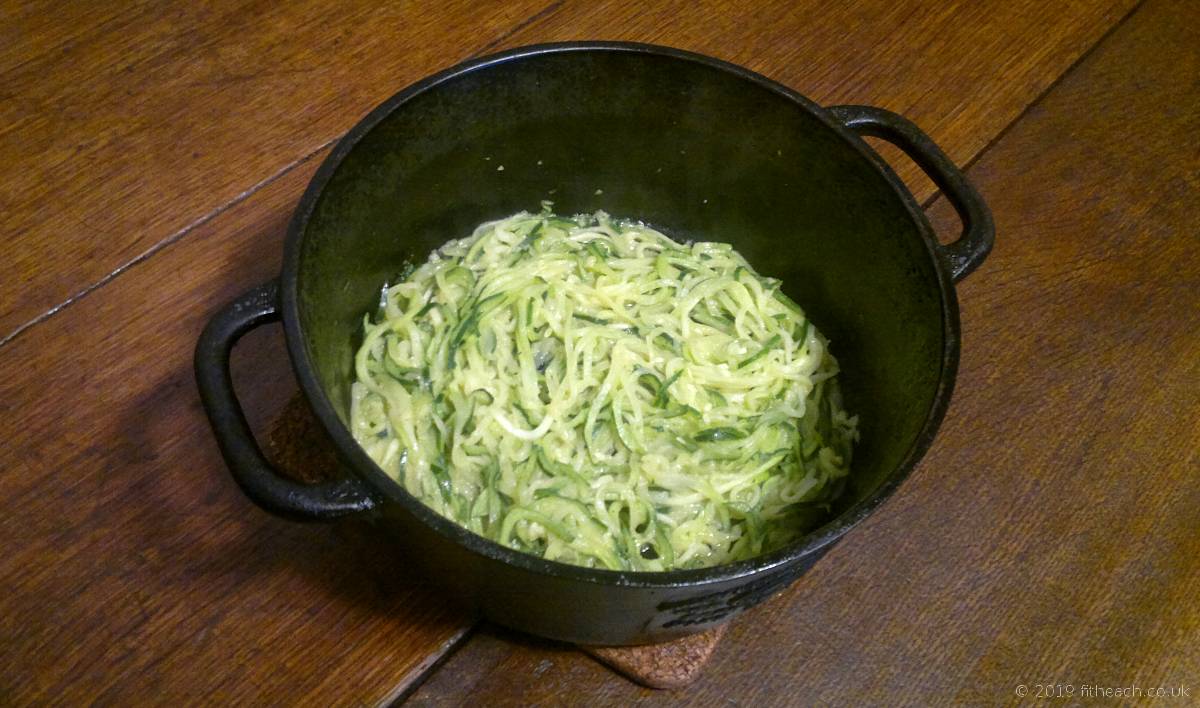For almost a year now I've been trying to minimise my intake of carbohydrates (carbs). Instead of getting my energy requirements from carbs, I get them from fats. Specifically, people refer to this as Low Carbohydrate, High Fat (LCHF). However, the terms lowcarb (low-carbohydrate) and keto (ketogenic) also get used for this eating regime, although they are slightly different. In practice, this means that I try to avoid high carb foods like pasta, rice, potato and bread. I haven't missed eating any of these foods in the last year, but it does create a problem if I want to eat certain styles of dishes. Take, for example, Bolognese sauce (ragù alla Bolognese), without spaghetti it is just fancy mince. There is a solution, and I call it courgetti. It is a compund word from "courgette" and "spaghetti". They are also frequently called zoodles, which is a compound of "zucchini" and "noodles". Whatever you call them, they work really well as a spaghetti or noodles replacement, and are easy to make. Of course, they are also low in carbs.

Spiraliser for making the courgetti strands
Making
To make courgetti you need a means of cutting long strips of courgette. It would be possible to do this using a knife or a vegetable peeler, but the results wouldn't be so satisfactory. The best and easiest way to make strips of courgette is to use a spiraliser (also spelled spiralizer). There are many spiralisers on the market, from very cheap to really expensive. I received mine as a Christmas present, so I can't tell you what it cost, but it wasn't that expensive. It does work amazingly well.
First thing to do is top and tail the courgette. If you have a particularly long courgette you may need to cut it in half to fit the spiraliser. Push the courgette onto the teeth at one end and then slide the courgette onto the spike at the other end. The spiraliser cuts the courgette with two offset blades as you turn the handle. The courgette then comes out of the spiraliser in several long strands.

Courgette loaded and ready to spiralise
The final 10mm of courgette remains uncut, as that portion is held by the teeth at the spiraliser's handle end. Don't throw away the end piece, you can always slice it using a knife and add it to the pan. The spirals of courgette are surprisingly strong and neither break when handling them or when cooking. The spiraliser can also be used for other vegetables, like carrots, and it will be interesting to find out if they are just as strong.

Spiralised courgette and left-over plug
Cooking
I suppose you could boil the courgetti in water, but that doesn't appeal to me. Oven roasting might be an alternative, which I will try in the future. My preferred method is to fry the courgetti in a heavy pan over a high heat for 5-10 minutes. I like the courgetti to be a little firm, so only fry them for 5 minutes. Cooked this way you could describe them as al dente. When frying, it is necessary to continuously stir and turn the courgetti in the pan to achieve even cooking. A small amount of fat will also be needed to stop the courgetti from sticking to the pan. I use butter, but use whatever is your preference. As a matter of taste I also add a pinch or two of salt. Courgetti are actually easier to make than spaghetti, as they don't stick together if you cook them for a few minutes too long.

Finished cooked courgetti in a heavy pan
That is all there is to it. Just serve in the same manner as you would spaghetti or noodles. Eating them are just as easy or difficult as for spaghetti. The individual strands can easily be as long as 40cm+, so make sure you have big forks. All I need to do now is find a lower carb alternative to Bolognese sauce, those tasty tomatoes are the problem.
Notes
- The very day I publish this article I have discovered a limitation in my model of spiraliser. The design of the teeth means that vegetables with a diameter less than 35mm aren't held firmly in place. The diameter of most courgettes will be greater than 35mm, but many carrots will be too thin.